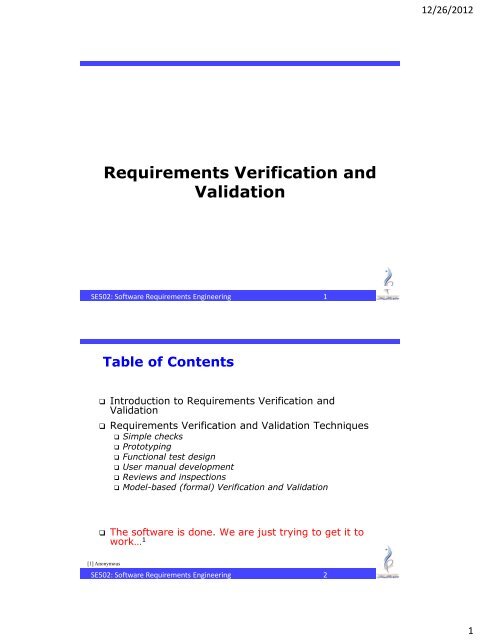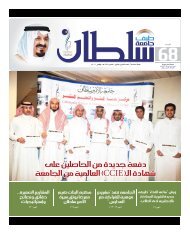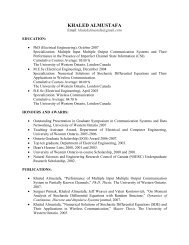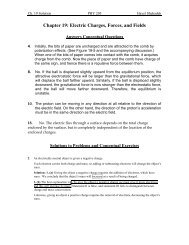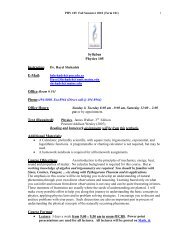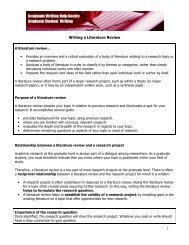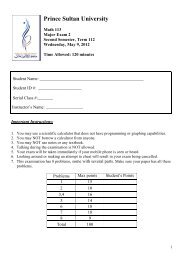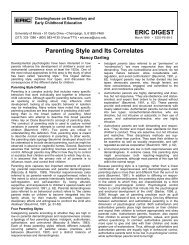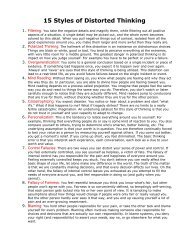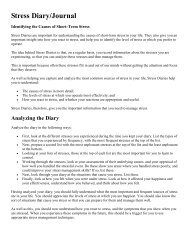Requirements Verification and Validation (2)
Requirements Verification and Validation (2)
Requirements Verification and Validation (2)
You also want an ePaper? Increase the reach of your titles
YUMPU automatically turns print PDFs into web optimized ePapers that Google loves.
12/26/2012<br />
SEG3101 (Fall 2010)<br />
<strong>Requirements</strong> <strong>Verification</strong> <strong>and</strong><br />
<strong>Validation</strong><br />
SE502: Software <strong>Requirements</strong> Engineering 1<br />
Table of Contents<br />
Introduction to <strong>Requirements</strong> <strong>Verification</strong> <strong>and</strong><br />
<strong>Validation</strong><br />
<strong>Requirements</strong> <strong>Verification</strong> <strong>and</strong> <strong>Validation</strong> Techniques<br />
Simple checks<br />
Prototyping<br />
Functional test design<br />
User manual development<br />
Reviews <strong>and</strong> inspections<br />
Model-based (formal) <strong>Verification</strong> <strong>and</strong> <strong>Validation</strong><br />
The software is done. We are just trying to get it to<br />
work… 1<br />
[1] Anonymous<br />
SE502: Software <strong>Requirements</strong> Engineering 2<br />
1
12/26/2012<br />
<strong>Requirements</strong> <strong>Verification</strong> <strong>and</strong><br />
<strong>Validation</strong><br />
<strong>Requirements</strong> <strong>Validation</strong><br />
Check that the right product is being built<br />
Ensures that the software being<br />
developed (or changed) will satisfy its<br />
stakeholders<br />
Checks the software requirements specification<br />
against stakeholders goals <strong>and</strong> requirements<br />
<strong>Requirements</strong> <strong>Verification</strong><br />
Check that product is being built right<br />
Ensures that each step followed in the process of<br />
building the software yields the right products<br />
Checks consistency of the software requirements<br />
specification artefacts <strong>and</strong> other software<br />
development products (design, implementation, ...)<br />
against the specification<br />
SE502: Software <strong>Requirements</strong> Engineering 3<br />
<strong>Requirements</strong> <strong>Verification</strong> <strong>and</strong><br />
<strong>Validation</strong> (2)<br />
Help ensure delivery of what the client wants<br />
Need to be performed at every stage during the<br />
(requirements) process<br />
Elicitation<br />
Checking back with the elicitation sources<br />
“So, are you saying that . . . . . ?”<br />
Analysis<br />
Checking that the domain description <strong>and</strong><br />
requirements are correct<br />
Specification<br />
Checking that the defined system requirement will<br />
meet the user requirements under the assumptions<br />
of the domain/environment<br />
Checking conformity to well-formedness rules,<br />
st<strong>and</strong>ards…<br />
SE502: Software <strong>Requirements</strong> Engineering 4<br />
2
12/26/2012<br />
V&V vs. Analysis<br />
Both have several activities in common<br />
Reading requirements, problem analysis, meetings <strong>and</strong><br />
discussions...<br />
Analysis works with raw, incomplete requirements as<br />
elicited from the system stakeholders<br />
Develop a software requirements specification document<br />
Emphasis on "we have the right requirements"<br />
<strong>Requirements</strong> V&V works with a software requirements<br />
specification <strong>and</strong> with negotiated <strong>and</strong> agreed (<strong>and</strong><br />
presumably complete) domain requirements<br />
Check that this these specifications are accurate<br />
Emphasis on "we have the right requirements well done"<br />
SE502: Software <strong>Requirements</strong> Engineering 5<br />
<strong>Requirements</strong> V&V<br />
Techniques<br />
SE502: Software <strong>Requirements</strong> Engineering 6<br />
3
12/26/2012<br />
Various <strong>Requirements</strong> V&V<br />
Techniques<br />
Simple checks<br />
Traceability, well-written requirements<br />
Prototyping<br />
Functional test design<br />
User manual development<br />
Reviews <strong>and</strong> inspections<br />
Walkthroughs<br />
Formal inspections<br />
Checklists<br />
Model-Based V&V<br />
First-order logic<br />
Behavioral models<br />
SE502: Software <strong>Requirements</strong> Engineering 7<br />
Simple Checks<br />
Various checks can be done using traceability<br />
techniques<br />
Given the requirements document, verify that all<br />
elicitation notes are covered<br />
Tracing between different levels of requirements<br />
Checking goals against tasks, features, requirements…<br />
Involves developing a traceability matrix<br />
Ensures that requirements have been taken into<br />
consideration (if not there should be a reason)<br />
Ensures that everything in the specification is justified<br />
Verify that the requirements are well written<br />
(according to the criteria already discussed)<br />
SE502: Software <strong>Requirements</strong> Engineering 8<br />
4
12/26/2012<br />
Prototyping (1)<br />
Excellent for validation by users <strong>and</strong> customers<br />
More accessible than specification<br />
Demonstrate the requirements <strong>and</strong> help stakeholders<br />
discover problems<br />
Come in all different shapes <strong>and</strong> sizes<br />
From paper prototype of a computerized system to<br />
formal executable models/specifications<br />
Horizontal, vertical<br />
Evolutive, throwaway<br />
SE502: Software <strong>Requirements</strong> Engineering 9<br />
Prototyping (2)<br />
Important to choose scenarios or use cases for<br />
elicitation session<br />
Prototyping-based validation steps<br />
Choose prototype testers<br />
Develop test scenarios<br />
Careful planning is required to draw up a set of<br />
test scenarios which provide broad coverage of<br />
the requirements<br />
Users should not just play around with the<br />
system as this may never exercise critical<br />
system features<br />
Execute test scenarios<br />
Document problems using a problem reporting tool<br />
SE502: Software <strong>Requirements</strong> Engineering 10<br />
5
12/26/2012<br />
Comment on next two techniques<br />
The two V&V techniques, namely Functional Test<br />
Design <strong>and</strong> User Manual Development, are not<br />
really V&V techniques.<br />
They are activities that must be performed<br />
anyway, <strong>and</strong> they are based on the specification<br />
document.<br />
Through these activities, as for any other<br />
activities based on the specification document,<br />
errors <strong>and</strong> other problems with this document<br />
may be detected.<br />
SE502: Software <strong>Requirements</strong> Engineering 11<br />
Functional Test Design<br />
Functional tests at the system level must be developed<br />
Derived from the requirements specification<br />
Each (functional) requirement should have an associated test<br />
Non-functional requirements are harder to validate with testing<br />
Each requirements test case must be traced to its requirements<br />
Inventing requirements tests is an effective validation technique<br />
Designing these tests may reveal errors in the<br />
specification (even before designing <strong>and</strong> building the<br />
system)!<br />
Missing or ambiguous information in the requirements description<br />
may make it difficult to formulate tests<br />
Some software development processes (e.g., agile<br />
methods) begin with tests before programming Test-<br />
Driven Development (TDD)<br />
SE502: Software <strong>Requirements</strong> Engineering 12<br />
6
12/26/2012<br />
User Manual Development<br />
Same reasoning as for functional test design<br />
Has to be done at some point<br />
Reveals problems earlier<br />
Forces a detailed look at requirements<br />
Particularly useful if the application is rich in<br />
user interfaces / for usability requirements<br />
Typical information in a user manual<br />
Description of the functionality<br />
How to get out of trouble<br />
How to install <strong>and</strong> get started with the system<br />
SE502: Software <strong>Requirements</strong> Engineering 13<br />
Reviews <strong>and</strong> Inspections (1)<br />
A group of people read <strong>and</strong> analyze<br />
requirements, look for potential problems, meet<br />
to discuss the problems, <strong>and</strong> agree on a list of<br />
action items needed to address these problems<br />
A widely used requirements validation technique<br />
Can be expensive<br />
Careful planning <strong>and</strong> preparation<br />
Pre-review checking<br />
Need appropriate checklists (must be developed if<br />
necessary <strong>and</strong> maintained)<br />
SE502: Software <strong>Requirements</strong> Engineering 14<br />
7
12/26/2012<br />
Reviews <strong>and</strong> Inspections (2)<br />
Different types of reviews with varying degrees of<br />
formality exist (similar to JAD vs. brainstorming sessions)<br />
Reading the document<br />
A person other than the author of the document<br />
Reading <strong>and</strong> approval (sign-off)<br />
Encourages the reader to be more careful (<strong>and</strong><br />
responsible)<br />
Walkthroughs<br />
Informal, often high-level overview<br />
Can be led by author/expert to educate others on<br />
his/her work<br />
Formal inspections<br />
Very structured <strong>and</strong> detailed review, defined roles<br />
for participants, preparation is needed, exit<br />
conditions are defined<br />
E.g., Fagan Inspection<br />
SE502: Software <strong>Requirements</strong> Engineering 15<br />
Reviews <strong>and</strong> Inspections (3)<br />
Different types of reviews (cont’d)<br />
Focused inspections<br />
Reviewers have roles, each reviewer looks<br />
only for specific types of errors<br />
SE502: Software <strong>Requirements</strong> Engineering 16<br />
8
12/26/2012<br />
Typical Review / Inspection Steps (1)<br />
Plan review<br />
The review team is selected <strong>and</strong> a time <strong>and</strong> place for the<br />
review meeting is chosen<br />
Distribute documents<br />
The requirements document is distributed to the review team<br />
members<br />
SE502: Software <strong>Requirements</strong> Engineering 17<br />
Typical Review / Inspection Steps (2)<br />
Prepare for review<br />
Individual reviewers read the requirements to find conflicts,<br />
omissions, inconsistencies, deviations from st<strong>and</strong>ards, <strong>and</strong><br />
other problems<br />
Hold review meeting<br />
Individual comments <strong>and</strong> problems are discussed <strong>and</strong> a set of<br />
action items to address the problems is established<br />
SE502: Software <strong>Requirements</strong> Engineering 18<br />
9
12/26/2012<br />
Typical Review / Inspection Steps (3)<br />
Follow-up actions<br />
The chair of the review checks that the agreed action items<br />
have been carried out<br />
Revise document<br />
<strong>Requirements</strong> document is revised to reflect the agreed action<br />
items<br />
At this stage, it may be accepted or it may be re-reviewed<br />
SE502: Software <strong>Requirements</strong> Engineering 19<br />
Review Team<br />
Reviews should involve a number of<br />
stakeholders drawn from different backgrounds<br />
People from different backgrounds bring different skills<br />
<strong>and</strong> knowledge to the review<br />
Stakeholders feel involved in the RE process <strong>and</strong><br />
develop an underst<strong>and</strong>ing of the needs of other<br />
stakeholders<br />
Review team should always involve at least a domain<br />
expert <strong>and</strong> a user<br />
SE502: Software <strong>Requirements</strong> Engineering 20<br />
10
12/26/2012<br />
Review – Problem Categorization<br />
<strong>Requirements</strong> clarification<br />
The requirement may be badly expressed or may have<br />
accidentally omitted information which has been collected during<br />
requirements elicitation<br />
Missing information<br />
Some information is missing from the requirements document<br />
<strong>Requirements</strong> conflict<br />
There is a significant conflict between requirements<br />
The stakeholders involved must negotiate to resolve the conflict<br />
Unrealistic requirement<br />
The requirement does not appear to be implementable with the<br />
technology available or given other constraints on the system<br />
Stakeholders must be consulted to decide how to make the<br />
requirement more realistic<br />
SE502: Software <strong>Requirements</strong> Engineering 21<br />
Fagan Inspection (1)<br />
Formal <strong>and</strong> structured inspection process<br />
Note: the boss is not<br />
involved in the process!<br />
SE502: Software <strong>Requirements</strong> Engineering 22<br />
11
12/26/2012<br />
Fagan Inspection (2)<br />
Characterized by rules on who should participate, how<br />
many reviewers should participate, <strong>and</strong> what roles they<br />
should play<br />
Not more than 2 hours at a time, to keep participants focused<br />
3 to 5 reviewers<br />
Author serves as the presenter of the document<br />
Metrics are collected<br />
Important: the author’s supervisor does not<br />
participate in the inspection <strong>and</strong> does not have<br />
access to data<br />
This is not an employee evaluation<br />
Moderator is responsible for initiating the inspection, leading the<br />
meeting, <strong>and</strong> ensuring issues found are fixed<br />
All reviewers need to prepare themselves using checklists<br />
Issues are recorded in special forms<br />
SE502: Software <strong>Requirements</strong> Engineering 23<br />
Fagan Inspection (3)<br />
The inspection meeting is like a brainstorming<br />
session to identify (potential) problems<br />
Re-inspection if > 5% of the document change<br />
Some variants are less tolerant... too easy to introduce<br />
new errors when correcting the previous ones!<br />
SE502: Software <strong>Requirements</strong> Engineering 24<br />
12
12/26/2012<br />
<strong>Requirements</strong> Review Checklists (1)<br />
Essential tool for an effective review process<br />
List common problem areas <strong>and</strong> guide reviewers<br />
May include questions an several quality aspects of the<br />
document: comprehensibility, redundancy,<br />
completeness, ambiguity, consistency, organization,<br />
st<strong>and</strong>ards compliance, traceability ...<br />
There are general checklists <strong>and</strong> checklists for<br />
particular modeling <strong>and</strong> specification languages<br />
Checklists are supposed to be developed <strong>and</strong><br />
maintained<br />
See examples on google<br />
SE502: Software <strong>Requirements</strong> Engineering 25<br />
<strong>Requirements</strong> Review Checklists (2)<br />
Sample of elements in a requirements review<br />
checklist<br />
Comprehensibility – can readers of the document<br />
underst<strong>and</strong> what the requirements mean?<br />
Redundancy – is information unnecessarily repeated in the<br />
requirements document?<br />
Completeness – does the checker know of any missing<br />
requirements or is there any information missing from<br />
individual requirement descriptions?<br />
Ambiguity – are the requirements expressed using terms<br />
which are clearly defined? Could readers from different<br />
backgrounds make different interpretations of the<br />
requirements?<br />
Consistency – do the descriptions of different<br />
requirements include contradictions? Are there<br />
contradictions between individual requirements <strong>and</strong><br />
overall system requirements?<br />
SE502: Software <strong>Requirements</strong> Engineering 26<br />
13
12/26/2012<br />
<strong>Requirements</strong> Review Checklists (3)<br />
Sample of elements (cont’d)<br />
Organisation – is the document structured in a sensible<br />
way? Are the descriptions of requirements organised so<br />
that related requirements are grouped?<br />
Conformance to st<strong>and</strong>ards – does the requirements<br />
document <strong>and</strong> individual requirements conform to<br />
defined st<strong>and</strong>ards? Are departures from the st<strong>and</strong>ards<br />
justified?<br />
Traceability – are requirements unambiguously<br />
identified? Do they include links to related<br />
requirements <strong>and</strong> to the reasons why these<br />
requirements have been included?<br />
SE502: Software <strong>Requirements</strong> Engineering 27<br />
Comments on Reviews <strong>and</strong> Inspections<br />
Advantages<br />
Effective (even after considering cost)<br />
Allow finding sources of errors (not only symptoms)<br />
<strong>Requirements</strong> authors are more attentive when they<br />
know their work will be closely reviewed<br />
Encourage them to conform to st<strong>and</strong>ards<br />
Familiarize large groups with the requirements (buy-in)<br />
Diffusion of knowledge<br />
Risks<br />
Need to be limited in time<br />
Time consuming <strong>and</strong> expensive (but usually cheaper<br />
than the alternative)<br />
SE502: Software <strong>Requirements</strong> Engineering 28<br />
14
12/26/2012<br />
Model-based (formal)<br />
<strong>Verification</strong> <strong>and</strong> <strong>Validation</strong><br />
SE502: Software <strong>Requirements</strong> Engineering 29<br />
Modeling paradigms<br />
Entity-Relationship modeling – e.g. UML Class diagrams<br />
Workflow modeling notations – there are many different<br />
“dialects”, such as UML Activity diagrams, UCM, BPML, Petri nets<br />
(a very simple formal model), Colored Petri nets<br />
State machines – e.g. Finite State Machines (FSM – a very<br />
simple formal model), extended FSMs, such as UML State<br />
diagrams<br />
First-order logic – notations such as Z, VDM, UML-OCL, etc.<br />
Can be used as an add-on with the other paradigms above,<br />
by providing information about data objects <strong>and</strong> relationships<br />
(possibly in the form of “assertions” or “invariants” that hold<br />
at certain points during the dynamic execution of the model)<br />
Can be used alone, expressing structural models <strong>and</strong><br />
behavioral models (there are many examples of using Z for<br />
such purpose)<br />
SE502: Software <strong>Requirements</strong> Engineering 30<br />
15
12/26/2012<br />
Formal V&V techniques <strong>and</strong> tools<br />
Available V&V techniques will vary from one modeling paradigms<br />
to another <strong>and</strong> will also depend on the available tools (that usually<br />
only apply to a particular modeling paradigm)<br />
The following functions may be provided through tools<br />
Completeness checking – only according to certain syntax rules,<br />
templates<br />
Consistency checking : given model M, show that M does not imply a<br />
contradiction <strong>and</strong> does not have any other undesirable general property (e.g.<br />
deadlock possibility)<br />
Model checking : given a model M <strong>and</strong> some properties P, show that any<br />
system implementation satisfying M will have the properties P<br />
Generation of system designs or prototype implementations<br />
(from workflow or state machine models)<br />
Generation of test cases<br />
SE502: Software <strong>Requirements</strong> Engineering 31<br />
Model checking<br />
Verifies that the model satisfies temporal logic<br />
properties, for example:<br />
If A occurs, B will occur in the future (eventually)<br />
If C occurs, D will be true always in the future<br />
Traverse systematically all possible behaviors<br />
(execution paths) of the machine (reachability<br />
analysis)<br />
<strong>Verification</strong> of properties done after reachability<br />
analysis or on the fly<br />
Model checker verifies M P (if no trace of states<br />
<strong>and</strong> transitions leading to the violation of P is found)<br />
– otherwise a counter example trace is provided<br />
Major obstacle is state space explosion<br />
Example tools:<br />
SPIN (see http://spinroot.com/spin/whatispin.html ) - for distributed systems with message passing<br />
Alloy (see http://alloy.mit.edu/community/ ) – for OO Class diagrams with assertions<br />
SE502: Software <strong>Requirements</strong> Engineering 32<br />
16


